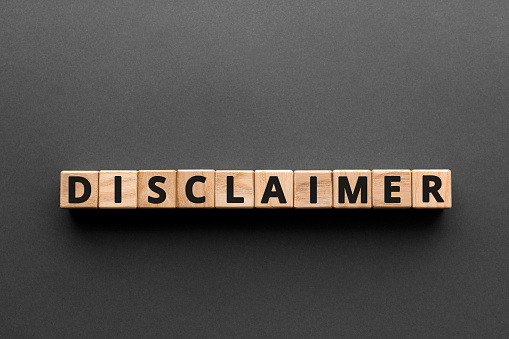Top 10 disclaimers every dot com business must have
11 Jan 2023
9 May 2022
min read

1. What are disclaimers?
Disclaimers are those statements in the terms and conditions of an online business that help limit the legal liability of the website/app owner in case of any loss/damage to the user arising due to the reliance or use of the content on the website/ app. It is a type of notice to the users of the website/platform/app/blog (‘Platform’) that the owners of the Platform would not be liable in any manner due to the damages arising out of the use of content (whether information, images or audio-visual content) on the Platform. While disclaimers are not a foolproof way to avoid any liability or lawsuits, they definitely help in putting up a strong defence during lawsuits or even reducing the number of damages/compensation that may be ordered by the court.
Disclaimers are as important as a ‘Privacy Policy’ or ‘Website terms of Service’ and must be included as a part of every Platform. The length of a disclaimer can vary from a short simple statement to a complex paragraph. Disclaimers also largely depend on the type of information/ product/service which is being offered through the Platform. There is no one-size-fits-all disclaimer, which could be copy-pasted or reproduced without making amendments thereto. If inappropriate disclaimers are used, then they would not provide the protection, and the entire purpose thereof would be lost. So while drafting disclaimers, the Platform owners need to keep in mind the possible legal risks that their business might face, which primarily depend on the content of the Platform and the activities it undertakes. As an example, if legal/ medical advice is offered, then the disclaimer would state that no attorney-client or doctor-patient relationship is formed by the use of the platform.

2. Why are they required?
While technology has eased the process of starting and setting up a new business through the internet. It has also increased the possibility of misuse of the content on a Platform like intellectual property violations, misuse of photos posted on the website, or claims arising due to damages suffered because of following the advice on the blog. While, at the time of posting such information or images, the possibility of a lawsuit is not anticipated, however, the threat is very real. Such a threat is much higher than a traditional business due to the sheer increase in volume and pace of the interactions with customers in the case of an online business, as opposed to a brick-and-mortar business. While in-person interactions in a traditional business allow for more personalized disclaimers to be made orally or correct and customized information to be communicated as per the needs of the consumers, this is usually not the case for online businesses.
Disclaimer can be used to claim ownership over the content posted on the Platform. It can be used to limit the liability of the Platform owner or to also disclaim liability for any interactions with third parties over the Platform.
3. Essentials of a valid disclaimer
In order for a disclaimer to be enforceable under law, it is imperative for it to be definitive and fair to the consumers/ users. Liability arising from negligence cannot be disclaimed by the Platform, nor can a Platform include disclaimers that are patently contrary to law, especially contract law.
4. Where should disclaimers appear?
Disclaimers can be included as a part of the terms and conditions of the Platform or included separately as browse-wrap or click-wrap agreements on the Platform. They can even be hyperlinked at the bottom of the website or as a part of the ‘About’ section in the app. Courts evaluate the content of the disclaimers as well as their placement on the Platform while adjudicating the legal liability of the Platform. However, wherever disclaimers are placed, they must serve as a reasonably conspicuous notice of contract terms to the consumers, in order to serve as an unambiguous manifestation of consumers’ assent and to safeguard against future potential legal issues. If disclaimers are hidden or difficult to find, the purpose is lost, and they are not considered by the courts while deciding liability, in such cases. Therefore, ideally, disclaimers should be the first pop-up that every user reads and agrees to, before beginning to use the platform.

5. What are the different types of disclaimers?
- Email Disclosures: This disclosure generally appears at the end of automated emails or formal correspondences for every Platform. The disclaimer would usually state that the information in the email, as well as any attachments thereto, is confidential and is intended to be used solely by the recipient and no other third party. This disclaimer expressly specifies that any use of the email contents by another person is unauthorised. This statement also disclaims any liability if there are viruses in the email or attachments.
- For general information only/ at user’s risk: This is one of the most common types of boilerplate disclaimer, which can be found at the bottom of every website or app. This disclaimer states that the contents of the Platform are for general information purposes only. The statement is used to clarify that the information on the platform may not be complete, updated, accurate, or suitable, and hence any reliance placed thereon is strictly at the risk of the user.
- Limitation of Liability: The limitation of liability disclosure is the most important and commonly appearing disclosure. It is used to disclaim any liability for any loss/damage, whether direct/ indirect/consequential, arising out of the use of the Platform or its contents. It is widely worded to limit all possible liabilities.
- No Responsibility for Technical Issues: Platforms use this measure to shrug off responsibility in case any user faces a loss/ damage due to technical issues which disrupt the smooth functioning of the Platform.
- No Responsibility for Third Party Content: Many Platforms allow third parties to post content on the Platform. This can be in the form of advertisements for the sale of products or services, information, advice, etc. This disclaimer is used by such Platforms to state that the Platform would not be liable for reliance by users on any content posted by third parties.
- Third-Party Links/ Affiliate Links: Some Platforms contain links to external websites/blogs/apps, which redirect the users to those external platforms for further information. This disclaimer is used to state that the Platform itself is not in control of the content on such external platforms. The disclaimer mentions that the inclusion of such third-party links on the Platform does not in itself imply a recommendation or endorsement of the views expressed on that platform.
- Past Performance on Financial or Investment: This disclaimer is generally used by Platforms allowing users to make financial investments through their websites or apps. The statement here clarifies that the performance represented on the platform is past performance and that it is not an accurate indicator of future results or potential profits/ losses. The disclaimer mentions that the value of an investment can greatly fluctuate and is not guaranteed.

-
- Not Professional Advice:
This is used by Platforms that provide legal/financial/medical or other professional information on their platform. This disclaimer states that the information and contents on the Platform are not a source of financial/ legal/ medical/ professional advice or analysis. The statement is used to clarify that the user uses the information at their own risk. This statement also expressly states that the use of the Platform by the user does not constitute any contractual relationship between the user and the Platform. This disclaimer is also used to clarify that the information on the Platform does not constitute any solicitation, recommendation, or endorsement, which may be contrary to the law of such jurisdiction.
-
Investment/financial advice: A platform for investment advice may go on to state that the user should fully understand the risks and merits of an investment before making an investment decision.
-
Legal Advice: The disclaimer states that the contents of the platform do not constitute formal legal advice and that the information is not a complete authority on a particular topic and needs to be modified by the user to meet the specific needs of the user. Further, this disclaimer clarifies that reliance on the contents of the platform does not constitute an attorney-client relationship between the user and the Platform, and hence their communication is not protected by the attorney-client privilege.
-
Medical Advice: The disclaimer in this case specifically mentions that the Platform content is not medical/health advice and that it is not intended to be substituted for professional medical advice or diagnosis or treatment. The disclaimer further clarifies that the information may not be updated, accurate, suitable, reliable, or complete and should be modified as per the specific needs of every individual. This statement advises users to seek professional medical advice from a qualified health care professional prior to starting a new medical regimen.
-
- Views/Opinions Expressed:
This disclaimer is used to prevent any liability which may arise due to the views of its employees/ advisers which have been posted on the Platform. It states that the views expressed are strictly those of the author and that it does not necessarily represent the views of the Platform itself.
- Errors and Omissions:
Platforms use this disclaimer to assume no responsibility if there are any errors or omissions in the contents of the website/ app. The disclaimer mentions that the content on the Platform is on an “as is” basis with no guarantees of completeness, accuracy, usefulness, or timeliness and without any warranties of any kind whatsoever, express or implied.
- Advertising Disclosure: This disclaimer is used by Platforms that allow third parties to advertise on their website/ apps. In order to safeguard itself from any liabilities arising due to such third-party ads, the Platforms include this disclosure which states that the appearance of the ad on the Platform, or the reference to the product does not constitute a guarantee or an endorsement of the advertised product/ service or its quality or value. The disclaimer provides that the Platform is not responsible in case the ad or its contents are illegal. The platform would also clarify that its contents are not influenced by advertisers thereon and that it has the discretion to refuse, reject, or cancel any such ads for any reason, at any time, without any liability.
- Marketing Text/ SMS: If any marketing messages or emails are sent by an online business, this disclaimer is included to state that the information in the text/ message/ email is for general information purposes only. The disclaimer states that the Platform endeavours to keep the information updated, correct and reliable, however, such information should not be relied upon by the user, and any such reliance is at the user’s own risk.
- Fair Use Disclosure: This disclaimer is used to prevent any liability which may arise due to infringement of any third party’s intellectual property. The disclaimer states that the Platform may contain a third party’s copyrighted material, reproduction of which may not have been authorised by the copyright owner. The Platform prevents any legal liability from arising by stating that the copyrighted material reproduced on the Platform is solely for research and education purposes, which counts as fair use of copyright-protected material. While using this disclaimer, however, every Platform must beware that there are no commercial gains due to the unauthorized reproduction of such protected material. The disclaimer must state that the Platform does not endorse any unauthorised use of the copyrighted material, which would not constitute ‘fair use thereof. Further, the disclaimer is used to warn the users that permission from the copyright owner is required to be taken if any user seeks to use the protected content for any other purpose. Further, every Platform must provide a grievance redressal email ID, which can be contacted by a user or member of the public, if their intellectual property is being violated due to the content on the Platform.
- Not Professional Advice:
Disclaimer Template
You can use template disclaimers available on Docpro’s website here.
Disclaimer: Please note that this is a general summary of the position under common law and does not constitute legal advice. As the laws of each jurisdiction may be different, you may wish to consult your lawyer.
Keywords:

